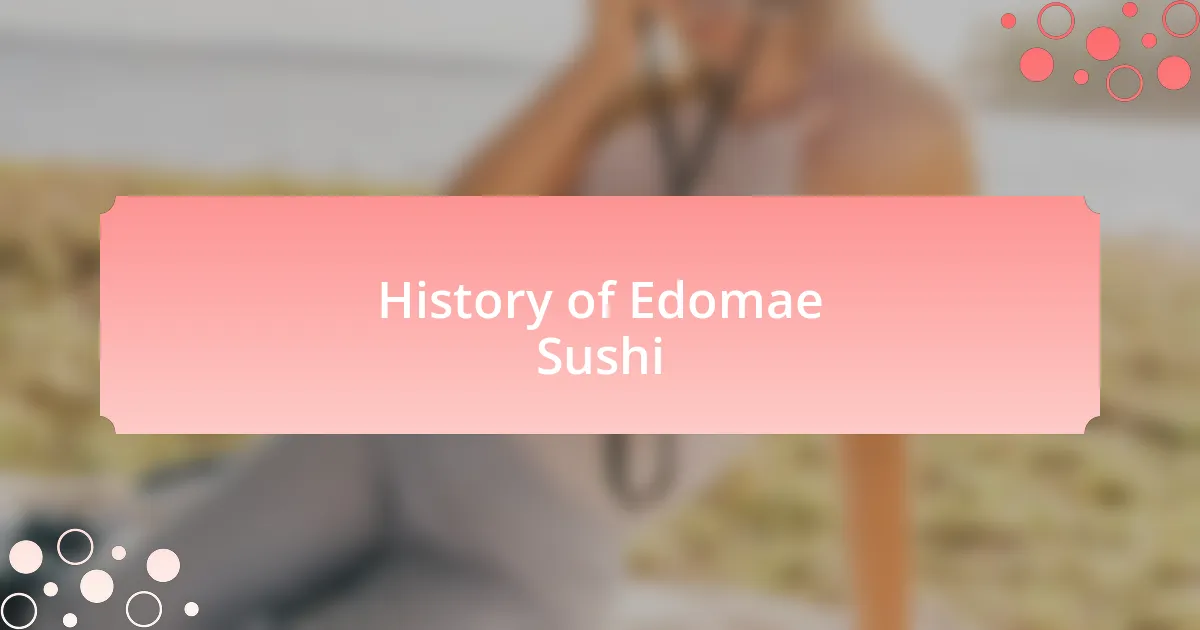Key takeaways:
- Edomae sushi, originating from the Edo period, emphasizes freshness and simplicity, allowing the natural flavors of fish to shine.
- Historically, it was a quick meal for the working class, evolving from preservation methods to a celebrated art form among skilled chefs.
- Key ingredients include fresh seafood from Tokyo Bay, seasoned rice, and thoughtfully paired garnishes that enhance the dish without overpowering it.
- Engaging with the chef during the dining experience and opting for omakase can greatly enhance appreciation and enjoyment of Edomae sushi.

What is Edomae Sushi
Edomae sushi, steeped in history, originates from the Edo period in Japan, dating back to the early 19th century. What I find captivating is how this style emphasizes simplicity and freshness, showcasing the natural flavors of the fish. When you take a bite, you’re not just tasting sushi; you’re experiencing a slice of Japanese culture.
Traditionally, Edomae sushi uses fish that’s been either marinated or prepared to highlight its unique characteristics, often paired with a touch of wasabi and served on seasoned rice. I can still remember the first time I tried it—it was a revelation. The nuanced flavors danced on my palate, leaving me curious: how can such simple ingredients create such a profound impact?
Beyond the ingredients, the preparation process is an art form, often requiring years of dedication. Imagine watching a sushi chef who has honed their skills, knowing exactly how to cut each piece for optimal flavor and texture. It’s not just food; it’s a testament to patience and respect for tradition, a feeling I recapture every time I observe the precision that goes into making Edomae sushi.

History of Edomae Sushi
The history of Edomae sushi dates back to the bustling Edo period, around the 1800s, when Tokyo was known as Edo. Originally, this type of sushi emerged as a quick meal for the working class, leveraging fresh catches from Tokyo Bay. I sometimes ponder how the fast-paced city life influenced this culinary tradition, allowing delicious flavors to evolve out of practicality.
In those early days, preservation methods like pickling and marinating were essential, as fishermen aimed to enhance freshness while extending the shelf life of their catches. Picture the streets where talented artisans crafted their creations into portable meals, turning simple fish into a cultural staple. I can almost visualize the vibrant market stalls, filled with laughter and the aroma of sushi wafting through the air.
What truly stands out to me is the transformation of Edomae sushi from a humble sustenance to a celebrated art form. Through generations, skilled chefs have refined their techniques, focusing on quality ingredients and meticulous preparation. Have you ever tasted sushi that felt like it was made just for you? That’s the essence of Edomae—where each piece is crafted with intention, and every bite invites you into a rich history that continues to evolve today.

Key Ingredients in Edomae Sushi
When it comes to Edomae sushi, the ingredients play a pivotal role in defining its unique character. Freshness is non-negotiable, with seafood sourced directly from Tokyo Bay. I recall my first taste of a beautifully seared eel; the subtle sweetness paired with a hint of smokiness was like tasting the essence of the ocean. It made me wonder, how can something so simple evoke such profound flavors?
The rice used in Edomae sushi is another key ingredient that sets it apart. It’s typically seasoned with a combination of rice vinegar, sugar, and salt, which creates a perfect balance of tanginess and sweetness. I remember being captivated by a sushi chef’s precise technique as he skillfully molded the rice. That moment was a revelation; I realized that the rice isn’t just a base—it’s the canvas on which the fish and garnishes come to life.
Let’s not overlook the garnishes and sauces that accompany Edomae sushi. Wasabi, pickled ginger, and soy sauce are frequently used to enhance the flavors, but they should never overpower the delicate taste of the fish. I once found myself enjoying an omakase experience where the chef expertly paired each piece with its ideal condiment. It showed me how these small details elevate Edomae sushi from simple fare to an extraordinary culinary journey.

How to Order Edomae Sushi
When ordering Edomae sushi, consider asking for an omakase experience, where the chef curates a selection for you. This was one of my most rewarding dining experiences. I felt like I was on a journey through flavors, with each piece telling a story that I couldn’t have chosen myself. Have you ever been surprised by a dish that you didn’t initially think you’d like? That’s the beauty of letting a skilled chef guide your meal.
Be mindful of the timing and setting when ordering your Edomae sushi. The atmosphere of the sushi bar can greatly enhance the experience. I once visited a cozy sushi spot during a quiet afternoon. The tranquility allowed me to fully savor the subtle nuances of each piece. I enjoyed how the soft lighting and the gentle conversation elevated my appreciation for the sushi.
Don’t hesitate to engage with the chef. I often find that asking questions about the ingredients or the preparation can lead to delightful conversations and even some unexpected recommendations. One time, I learned about the tradition behind a particular type of fish that I had ordered. This added an extra layer of appreciation to my meal and made it even more memorable. So, are you ready to dive into the world of Edomae sushi?

My Favorite Edomae Sushi Experiences
One of my favorite Edomae sushi experiences took place during a visit to a place that specialized in seasonal ingredients. Each piece showcased the freshest fish, but it was the mackerel that truly stood out. I can still remember the explosion of flavor as the chef educated me about its curing process—who knew something as simple as salt could transform the fish into a culinary masterpiece?
Another unforgettable moment was when I sat at the bar, completely captivated by the chef’s meticulous movements. Watching him create each piece with such care and precision felt almost meditative. It brought to mind the age-old saying that food is made with love. Can you really appreciate sushi without understanding the passion put into it? I think not.
I also cherish the time when I had the opportunity to try a unique pairing of Edomae sushi with a traditional sake. The smoothness of the sake complemented the delicate flavors of the sushi perfectly, elevating my entire experience. It led me to ponder how certain ingredients, when paired thoughtfully, can take your meal to a whole new level. Have you ever explored how drink choices can enhance the culinary adventure? It’s something that has certainly enriched my own sushi outings.